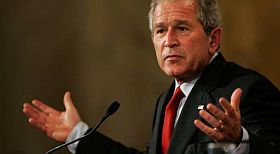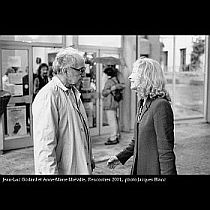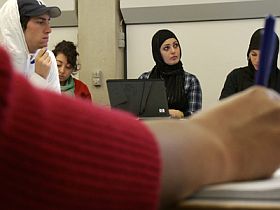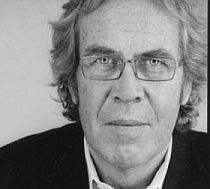This years festival Cinéma du reel had a program called Nous deux – Both of us, featuring films made by filmmakers in couples or pairs. Amongst those shown where The Old Place (1998) and Reportage amateur (maquette expo) (2006) by Anne-Marie Miéville and Jean-Luc Godard, who have been partners and made films together since the 1970s. Since I could not attend to the screening, I acquired the DVD of four short films by Godard and Miéville: De l’origine du XXIe siècle (2000), The Old Place (1998), Liberté et Patrie (2002) and Je vous salue Sarajevo (1993) (ECM Cinema 2006).
I highly recommend this edition, which is the first DVD released from the renowned German record label ECM Records. The DVD-cover is actually a fine little book with beautifully reproduced stills from the films, an introduction by the German film critic Michael Althen as well as the complete dialogues. All of this in French, English and German.
Link to ECM Records
EMC has also released the complete soundtrack of Godard’s Histoire(s) du Cinéma, a boxed set of 5 CDs:
http://www.ecmrecords.com/Catalogue/New_Series/1700/1706.php?cat=&we_start=0&lvredir=712&we_search=%2Bcinema
Godard will be celebrating his eightieth birthday in December of this year, and it is also the fifty-year anniversary for À bout de souffle (Breathless 1960). On this occasion French film historian and critic Antoine de Baecque recently published ”la première biographie en France de l’impossible M. Godard”: Godard (Grasset 2010), a massive volume of almost a thousand pages, the fruit of years of meticulous archive work. I quote: Mais ce qui rend passionnante l’audace biographique dans le cas de Godard est sa manière d’incarner à tout instant un moment d’histoire. Cet artiste est un radar, la plaque sensible de son époque, le meilleur sismographe des mouvements de société et des ruptures qui parcourent la vie collective, en France et bien souvent dans le monde occidental (Godard, p. 10). (But what is passionate about the audacity of a biographical project in the case of Godard, is his way of embodying, constantly, a moment of history. This artist is a radar, the sensitive plate of his time, the best seismograph of movements in society and the ruptures that runs trough collective social life, in France and most often, in the Western world (Godard, p. 10, my translation)).
http://www.lemonde.fr/livres/article/2010/03/11/godard-d-antoine-de-baecque_1317505_3260.html
(If you only read English, you will have to do with: Godard, a Portrait of the Artist at Seventy by Colin MacCabe (Bloomsbury, 2003) and Everything Is Cinema. The Working Life of Jean-Luc Godard by Richard Brody (Metropolitan Books, 2008).)
Antoine de Baecque also wrote the scenario for the documentary Deux de la Vague (Films à Trois 2009, 90 min.) by Emmanuel Laurent, shown at Cannes last year, which tells the story of the friendship between Godard and Truffaut:
http://www.filmsatrois.com/index.php?option=com_content&view=article&id=76%3Ales-deux-de-la-vague&lang=en&showall=1
Godard will be presenting his latest film, Film Socialisme, (featuring Patti Smith among many others), at this years Cannes festival in the selection Un Certain Regard, whose jury this year is presided over by the French director Claire Denis.
Godard has made six trailers for the film, here are some: http://www.youtube.com/watch?v=SS09nVRBimo, http://www.youtube.com/watch?v=ZhqOFWdtDdY&feature=related
And a little bonus for the end:
Godard and Miéville’s 1992 contribution to a series of cigarette ads directed by prestigious filmmakers: http://www.youtube.com/watch?v=icx7rB7WdDw (Those were the days!).
And while we’re at it..:
http://curtisway.blogspot.com/2008/04/parisienne-people.html
Photo (Jacques Blanc): Jean-Luc Godard and Anne-Marie Miéville in Rencontres (2001)












